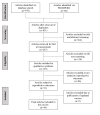Medical and Surgical Treatment of Reproductive Outcomes in Polycystic Ovary Syndrome: An Overview of Systematic Reviews
- PMID: 31710185
- PMCID: PMC6875858
- DOI: 10.22074/ijfs.2020.5608
Medical and Surgical Treatment of Reproductive Outcomes in Polycystic Ovary Syndrome: An Overview of Systematic Reviews
Abstract
Polycystic ovary syndrome (PCOS) is a common, complex condition that affects up to 18% of reproductiveaged women, causing reproductive, metabolic and psychological dysfunctions. We performed an overview and appraisal of methodological quality of systematic reviews that assessed medical and surgical treatments for reproductive outcomes in women with PCOS. Databases (MEDLINE, EMBASE, CINAHL PLUS and PROSPERO) were searched on the 15th of September 2017. We included any systematic review that assessed the effect of medical or surgical management of PCOS on reproductive, pregnancy and neonatal outcomes. Eligibility assessment, data extraction and quality assessment by the Assessing the Methodological Quality of Systematic Reviews (AMSTAR) tool were performed in duplicate. We identified 53 reviews comprising 44 reviews included in this overview; the majority were moderate to high quality. In unselected women with PCOS, letrozole was associated with a higher live birth rate than clomiphene citrate (CC), while CC was better than metformin or placebo. In women with CC-resistant PCOS, gonadotrophins were associated with a higher live birth rate than CC plus metformin, which was better than laparoscopic ovarian drilling (LOD). LOD was associated with lower multiple pregnancy rates than other medical treatments. In women with PCOS undergoing in vitro fertilization/intracytoplasmic sperm injection (IVF/ICSI), the addition of metformin to gonadotrophins resulted in less ovarian hyperstimulation syndrome (OHSS), and higher pregnancy and live birth rates than gonadotrophins alone. Gonadotrophin releasing hormone (GnRH) antagonist was associated with less OHSS, gonadotrophin units and shorter stimulation length than GnRH agonist. Letrozole appears to be a good first line treatment and gonadotrophins, as a second line treatment, for anovulatory women with PCOS. LOD results in lower multiple pregnancy rates. However, due to the heterogeneous nature of the included populations of women with PCOS, further larger scale trials are needed with more precise assessment of treatments according to heterogeneous variants of PCOS.
Keywords: Infertility; Polycystic Ovary Syndrome; Review; Therapeutics; Treatment Outcome.
Copyright© by Royan Institute. All rights reserved.
Conflict of interest statement
The authors declare no conflicts of interest.
Similar articles
-
Laparoscopic ovarian drilling for ovulation induction in women with anovulatory polycystic ovary syndrome.Cochrane Database Syst Rev. 2020 Feb 11;2(2):CD001122. doi: 10.1002/14651858.CD001122.pub5. Cochrane Database Syst Rev. 2020. PMID: 32048270 Free PMC article.
-
First-line ovulation induction for polycystic ovary syndrome: an individual participant data meta-analysis.Hum Reprod Update. 2019 Nov 5;25(6):717-732. doi: 10.1093/humupd/dmz029. Hum Reprod Update. 2019. PMID: 31647106
-
Ultrasound-guided transvaginal ovarian needle drilling for clomiphene-resistant polycystic ovarian syndrome in subfertile women.Cochrane Database Syst Rev. 2019 Jul 31;7(7):CD008583. doi: 10.1002/14651858.CD008583.pub2. Cochrane Database Syst Rev. 2019. Update in: Cochrane Database Syst Rev. 2021 Nov 4;11:CD008583. doi: 10.1002/14651858.CD008583.pub3. PMID: 31425630 Free PMC article. Updated. Review.
-
Conventional GnRH antagonist protocols versus long GnRH agonist protocol in IVF/ICSI cycles of polycystic ovary syndrome women: a systematic review and meta-analysis.Sci Rep. 2022 Mar 15;12(1):4456. doi: 10.1038/s41598-022-08400-z. Sci Rep. 2022. PMID: 35292717 Free PMC article.
-
GnRH antagonist versus long agonist protocols in IVF: a systematic review and meta-analysis accounting for patient type.Hum Reprod Update. 2017 Sep 1;23(5):560-579. doi: 10.1093/humupd/dmx017. Hum Reprod Update. 2017. PMID: 28903472
Cited by
-
H6PD Gene Polymorphisms (R453Q and D151A) and Polycystic Ovary Syndrome: A Case-Control Study in A Population of Iranian Kurdish Women.Int J Fertil Steril. 2022 Aug 21;16(3):180-183. doi: 10.22074/ijfs.2021.141690.1050. Int J Fertil Steril. 2022. PMID: 36029054 Free PMC article.
-
The comparative effectiveness of 55 interventions in obese patients with polycystic ovary syndrome: A network meta-analysis of 101 randomized trials.PLoS One. 2021 Jul 19;16(7):e0254412. doi: 10.1371/journal.pone.0254412. eCollection 2021. PLoS One. 2021. Retraction in: PLoS One. 2025 Jul 9;20(7):e0327327. doi: 10.1371/journal.pone.0327327. PMID: 34280195 Free PMC article. Retracted.
-
The relationship between polycystic ovary syndrome and infertility: a bibliometric analysis.Ann Transl Med. 2022 Mar;10(6):318. doi: 10.21037/atm-22-714. Ann Transl Med. 2022. PMID: 35434010 Free PMC article.
-
Insulin-sensitizing agents for infertility treatment in woman with polycystic ovary syndrome: a narrative review of current clinical practice.Hormones (Athens). 2024 Mar;23(1):49-58. doi: 10.1007/s42000-023-00494-y. Epub 2023 Oct 4. Hormones (Athens). 2024. PMID: 37792213 Review.
-
Recent Advances in Treatment of Recurrent Spontaneous Abortion.Obstet Gynecol Surv. 2022 Jun;77(6):355-366. doi: 10.1097/OGX.0000000000001033. Obstet Gynecol Surv. 2022. PMID: 35672876 Free PMC article. Review.
References
-
- Balen AH, Morley LC, Misso M, Franks S, Legro RS, Wijeyaratne CN, et al. The management of anovulatory infertility in women with polycystic ovary syndrome: an analysis of the evidence to support the development of global WHO guidance. Hum Reprod Update. 2016;22(6):687–708. - PubMed
-
- Thessaloniki ESHRE/ASRM-Sponsored PCOS Consensus Workshop Group. Consensus on infertility treatment related to polycystic ovary syndrome. Hum Reprod. 2008;23(3):462–477. - PubMed
-
- Conway G, Dewailly D, Diamanti-Kandarakis E, Escobar-Morreale HF, Franks S, Gambineri A, et al. The polycystic ovary syndrome: a position statement from the European Society of Endocrinology. Eur J Endocrinol. 2014;171(4):P1–P29. - PubMed
-
- Stein IF, Leventhal ML. Amenorrhea associated with bilateral polycystic ovaries. Am J Obstet Gynecol. 1935;29(2):181–191.
-
- Azziz R, Carmina E, Dewailly D, Diamanti-Kandarakis E, Escobar- Morreale HF, Futterweit W, et al. The androgen excess and PCOS society criteria for the polycystic ovary syndrome: the complete task force report. Fertil Steril. 2009;91(2):456–488. - PubMed
Publication types
LinkOut - more resources
Full Text Sources

